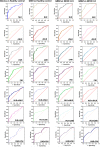The role of preoperative inflammatory markers in patients with central nervous system tumors, focus on glioma
- PMID: 36483052
- PMCID: PMC9723353
- DOI: 10.3389/fonc.2022.1055783
The role of preoperative inflammatory markers in patients with central nervous system tumors, focus on glioma
Abstract
Background: CNS tumors, particularly gliomas, are associated with a high rate of disability and lethality, and are typically diagnosed with histopathology and immunohistochemistry. Our research aims to develop a minimally invasive method for diagnosing, grading and molecular typing glioma.
Methods: We collected patients who underwent surgery for glioma, Trigeminal neuralgia/Hemifacial spasm, schwannoma, pituitary adenomas and meningioma at our hospital from June 2019 to June 2021. Preoperative WBCs, neutrophils, lymphocytes, monocytes, platelet counts and albumin levels were collected. Preoperative NLR, dNLR, PLR, LMR and PNI were calculated, and the correlation between them and glioma diagnosis as well as grading was analyzed. We also evaluated the diagnostic significance of NLR, dNLR, PLR, LMR, PNI and their combinations for gliomas, particularly GBM, as well as the diagnostic significance of IDH molecular typing of gliomas.
Results: There were 182 healthy samples and 3101 diseased samples in our study. Compared with other groups, glioma patients had significantly higher preoperative NLR, dNLR and PLR values, but lower LMR and PNI values. Further analysis showed that NLR, dNLR, and PLR were positively correlated with glioma grading, while LMR and PNI were negatively correlated with glioma grading. For the diagnosis of glioma, NLR showed a maximum AUC value of 0.8099 (0.7823-0.8374). For GBM, NLR showed a maximum AUC value of 0.9585 (0.9467-0.9703). In the combination, NLR+dNLR showed the highest AUC value of 0.8070(0.7849-0.8291). NLR showed significant statistical significance in all grades of glioma IDH molecular typing, while PLR did not show statistical significance.
Conclusions: NLR has the greatest value for the diagnosis, differential diagnosis, grading and molecular typing of gliomas. The NLR+dNLR combination also showed high sensitivity and specificity. We believe that inflammatory parameters may serve as economical and specific markers for glioma diagnosis, grading, molecular typing, and progression.
Keywords: IDH status; diagnosis; glioma; inflammatory markers; meningioma; molecular typing.
Copyright © 2022 Chen, Chao, Huang, Guo, Zhai, Wang, Wang, Xie, Wang and Ji.
Conflict of interest statement
The authors declare that the research was conducted in the absence of any commercial or financial relationships that could be construed as a potential conflict of interest.
Figures





Similar articles
-
Blood-based biomarkers: diagnostic value in brain tumors (focus on gliomas).Front Neurol. 2023 Oct 23;14:1297835. doi: 10.3389/fneur.2023.1297835. eCollection 2023. Front Neurol. 2023. PMID: 37936915 Free PMC article.
-
Diagnostic value of preoperative inflammatory markers in patients with glioma: a multicenter cohort study.J Neurosurg. 2018 Sep;129(3):583-592. doi: 10.3171/2017.3.JNS161648. Epub 2017 Nov 3. J Neurosurg. 2018. PMID: 29099300
-
Peripheral Inflammatory Blood Markers in Diagnosis of Glioma and IDH Status.J Neurosci Rural Pract. 2021 Jan;12(1):88-94. doi: 10.1055/s-0040-1721166. Epub 2021 Jan 10. J Neurosci Rural Pract. 2021. PMID: 33551616 Free PMC article.
-
Correlation between preoperative inflammatory markers, Ki-67 and the pathological grade of glioma.Medicine (Baltimore). 2021 Sep 10;100(36):e26750. doi: 10.1097/MD.0000000000026750. Medicine (Baltimore). 2021. PMID: 34516487 Free PMC article.
-
Prognostic Significance of Preoperative Systemic Cellular Inflammatory Markers in Gliomas: A Systematic Review and Meta-Analysis.Clin Transl Sci. 2020 Jan;13(1):179-188. doi: 10.1111/cts.12700. Epub 2019 Oct 30. Clin Transl Sci. 2020. PMID: 31550075 Free PMC article.
Cited by
-
Blood-based biomarkers: diagnostic value in brain tumors (focus on gliomas).Front Neurol. 2023 Oct 23;14:1297835. doi: 10.3389/fneur.2023.1297835. eCollection 2023. Front Neurol. 2023. PMID: 37936915 Free PMC article.
-
Predictive value of peripheral blood inflammatory markers for epilepsy occurrence in traumatic brain injury patients.Acta Epileptol. 2025 Jun 26;7(1):36. doi: 10.1186/s42494-025-00226-2. Acta Epileptol. 2025. PMID: 40571946 Free PMC article.
References
LinkOut - more resources
Full Text Sources

